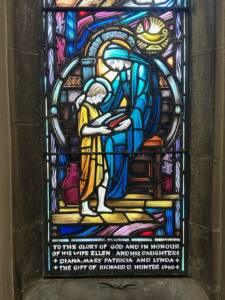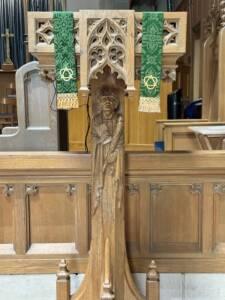 St. Timothy’s life story emerges through a blend of biblical writings and tradition. Our church tells it through two stained glass windows and a wood carving. If you stand about halfway up the center aisle, facing the chancel, and look up to the right, you will see a large three-tiered window that incorporates prominent, warm, golden tones. At the base, Timothy is shown in childhood alongside his mother Eunice and grandmother Lois, reminding us that faith often begins at home. The central panel depicts St. Paul ordaining him through the laying on of hands, a gesture of commissioning that has continued in Christian ministry through the centuries. At the top, Timothy appears in the fullness of his vocation, teaching the scriptures as a leader of the church. In our Children’s Chapel, the lower tier of the left-most window also shows him as a child with a female figure—perhaps his mother—again emphasizing the theme of family faith. The carved lectern, however, adds a sobering note: it portrays Timothy as a young man holding a wooden club, a symbol of his eventual martyrdom.
St. Timothy’s life story emerges through a blend of biblical writings and tradition. Our church tells it through two stained glass windows and a wood carving. If you stand about halfway up the center aisle, facing the chancel, and look up to the right, you will see a large three-tiered window that incorporates prominent, warm, golden tones. At the base, Timothy is shown in childhood alongside his mother Eunice and grandmother Lois, reminding us that faith often begins at home. The central panel depicts St. Paul ordaining him through the laying on of hands, a gesture of commissioning that has continued in Christian ministry through the centuries. At the top, Timothy appears in the fullness of his vocation, teaching the scriptures as a leader of the church. In our Children’s Chapel, the lower tier of the left-most window also shows him as a child with a female figure—perhaps his mother—again emphasizing the theme of family faith. The carved lectern, however, adds a sobering note: it portrays Timothy as a young man holding a wooden club, a symbol of his eventual martyrdom.
Timothy’s story intertwines with that of Paul, but it begins in his hometown of Lystra, near modern-day Konya in Turkey. He was raised in a multicultural family—his mother Eunice and grandmother Lois were Jewish, while his father was Greek. When Paul first visited Lystra on his initial missionary journey, they became part of the Christian community he founded there. Timothy grew up in the faith his family had embraced through Paul’s teaching. By the time Paul returned on his second journey in the 50s AD, Timothy was already a respected member of that congregation. Paul invited him to join his travels, and Timothy agreed, even undergoing circumcision as an adult so that he could minister effectively among Jewish communities.
 From that point on, Timothy became Paul’s close companion and trusted envoy. Together they journeyed to Macedonia, and to several great cities of the empire: Philippi, Athens, and Corinth. Paul later sent Timothy to congregations on his own, entrusting him with delicate missions of encouragement and correction. In his letters, Paul spoke of Timothy as his “true son in the faith,” praising his compassion, loyalty, and faithfulness. Timothy is named as co-author on several of Paul’s letters, a sign of deep respect and shared authority. Paul described the two of them together as “slaves of Christ Jesus,” underscoring their common devotion.
From that point on, Timothy became Paul’s close companion and trusted envoy. Together they journeyed to Macedonia, and to several great cities of the empire: Philippi, Athens, and Corinth. Paul later sent Timothy to congregations on his own, entrusting him with delicate missions of encouragement and correction. In his letters, Paul spoke of Timothy as his “true son in the faith,” praising his compassion, loyalty, and faithfulness. Timothy is named as co-author on several of Paul’s letters, a sign of deep respect and shared authority. Paul described the two of them together as “slaves of Christ Jesus,” underscoring their common devotion.
Beyond the references in Paul’s letters, Timothy also appears in the Acts of the Apostles, the earliest attempt to tell the history of the spread of the Christian faith.The so-called Pastoral Epistles (1 and 2 Timothy), describe his ministry in Ephesus, though scholars now view these letters as products of the second century rather than direct correspondence from Paul himself. Even so, they preserve memories of Timothy’s ministry, including his frail health and the challenges he faced in securing pastoral authority as a younger person.
Tradition holds that Timothy remained in Ephesus as its first bishop, faithfully teaching and guiding the church until his death near the end of the first century. Accounts of his martyrdom differ, but most recall his confrontation with pagan practices and his death by beating—hence the carved club in our lectern. While the exact details remain uncertain, the memory of his witness endures.
The meaning of his name, Timotheos, is itself a legacy: it can mean either “honoring God” or “honored by God.” Perhaps both are true at once. Timothy’s life embodies the mutual relationship at the heart of Christian faith—our call to honor God, and the assurance that each of us is held in God’s honor and dignity.
Quick Facts about St. Timothy
- Name: Timotheos — “honouring God” or “honoured by God”
- Family: Mother Eunice and grandmother Lois (Jewish), father Greek
- Hometown: Lystra (modern-day Konya, Turkey)
- Introduced to faith: Through Paul’s first visit to Lystra
- Joined Paul: On Paul’s second journey (c. 50s AD)
- Travels: Macedonia, Philippi, Athens, Corinth, and beyond
- Role: Paul’s close companion, co-author of letters, later bishop of Ephesus
- Symbols in our church:
- Main window: childhood with family, ordination by Paul, teaching ministry
- Side chapel window: Timothy as a child with a female figure (likely his mother)
- Lectern carving: Timothy as a young man holding the club of his martyrdom
- Main window: childhood with family, ordination by Paul, teaching ministry
- Death: Martyred in Ephesus near the end of the 1st century
